
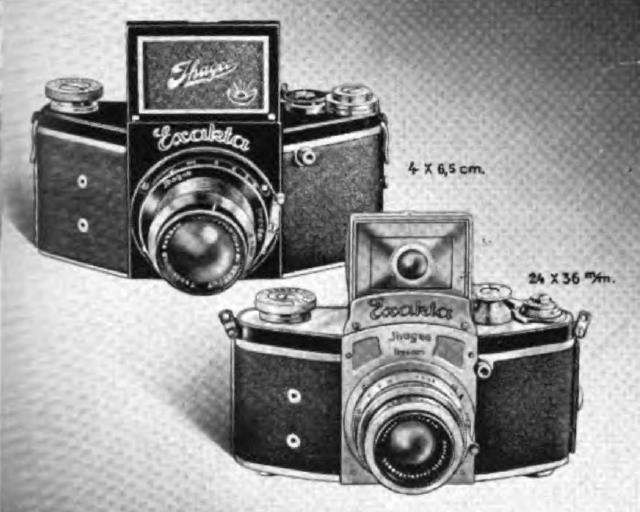
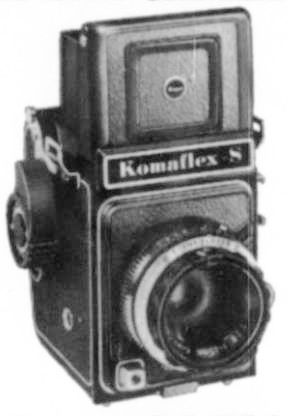
A very few SLR cameras were made that used 127 roll film. The first Exakta cameras, from 1933, did so; later, the Exakta VP, with VP standing for Vest Pocket, and the Night Exakta were versions of the 127 film Exakta. Shown at right is an image from a 1937 advertisement in which both a 127 film Exakta and a 35mm Kine Exakta are shown, the latter being in the foreground. Another was the Komaflex-S from 1960 by Kowa, pictured at left, but that camera did not have interchangeable lenses. One possible reason for the relative lack of SLRs in this format is that while Kodak made Kodachrome film available in 35mm and as 620 roll film, it was not available as 127 roll film. Kodachrome was very popular for its vivid colors, but it required a complex procedure for processing, unlike ordinary color films, such as Kodak's own Ektachrome and the color films made by all other companies. Kodak did make Kodachrome film in the 828 format, for use with their Bantam Colorsnap camera, for example.
Kodachrome was the first modern color film, in the sense that it used a subtractive process. Earlier color films, such as Autochrome, used an additive process, which was wasteful of light in exposure and projection, as well as greatly limiting resolution.
Unlike later films, Kodachrome was unique in that the color couplers were introduced to the film by the chemicals used to develop it, rather than being part of the film itself. This made the process for developing Kodachrome much more difficult and complex than that used for later color films. It may have contributed to the longer archival life of Kodachrome film than that of other color films, and this also made the emulsion layers thinner, helping to give the film a higher resolution.
Kodachrome film also had a wider dynamic range than other color films, allowing more highlights and shadows to be visible in color.
While it is remembered for its vivid colors, those colors were also highly accurate as well.
Kodachrome was introduced in 1935, with a speed of ASA 10. It was only in 1961 that Kodachrome II came out at ASA 25, but the very next year, Kodachrome-X provided ASA 64 to the photographer.
In 1936, Agfacolor was introduced. This is a color slide film of the general type that was simpler to develop than Kodachrome; Kodak's first film of that type, Ektachrome, dates from 1946. Fuji Color Film dates from 1948, and Anscochrome, made by an American company that entered the photographic film market, dates from 1955.
Kodacolor, which dates from 1942, was the world's first color negative film used to print photographs on color photographic paper. Incidentally, Eastman Kodak had previously used the name Kodacolor, staring in 1928, for a lenticular three-color motion picture film.
The following diagram, similar to some that have appeared in science textbooks and other such places, shows how modern color films work:

The film is exposed to light of all colors that forms an image, shown by incoming rays of red, green, and blue light.
The topmost emulsion layer of the film is sensitive only to blue light, which is how photographic film naturally is, unless it is sensitized to other colors by having special chemicals added, and so it records an image of the blue light from the object.
A yellow filter layer then blocks the blue light from going further.
The next emulsion layer is partially sensitized so that it can record green light, but is still insensitive to red light, and so it records an image of the green light from the object.
A red filter layer then blocks all but the red light from going further.
The bottom emulsion layer is fully sensitized, so that it can record red light, and thus this one records an image of the red light from the object.
This just illustrates one type of color film, perhaps the simplest to understand. For example, Eastman Kodak made some color films where the bottom layer was sensitized to red light but not to green light, so that while the yellow filter layer was still needed, the red filter layer could be omitted.
Also, it only shows how the three images needed for color photography are recorded; the steps needed to make use of them, to produce either a direct positive for use in movie film or as a color slide, or a color negative from which to make photographic prints are quite complicated.
Although this page does not have the space to do the subject justice, here are a few examples of images made with different types of color film to give an idea of what is being discussed.
First, this image shows the structure of the colored grains of potato starch that allow an Autochrome photograph to be in color:
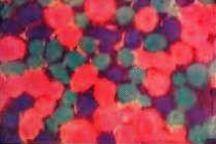
Note the unusual choice of additive primaries: red-orange, cyan, and a\ slightly purplish dark blue.
Now, here is an example of a photograph taken by the Autochrome process. As the process of reproducing it on the printed page may have affected its quality for the worse, I have made the attempt to adjust its colors, but the limitation of the Autochrome process, a very narrow dynamic range for the image, should still be visible:
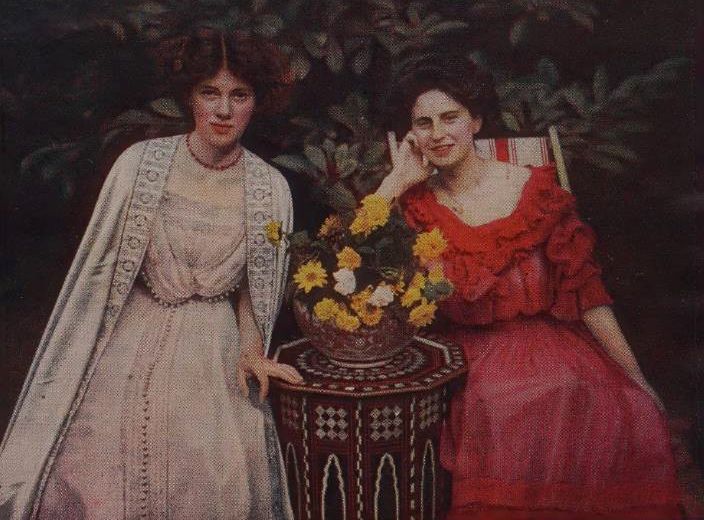
Here is an example of a Kodachrome image. Note the choice of a very demanding subject, three girls dancing in colorful traditional costumes, so that many different shades of red with small differences are visible.

In a booklet showing off the virtues of Agfachrome film, none of the sample images presented were as demanding; still, this sample image seems to show a very good quality of color reproduction.
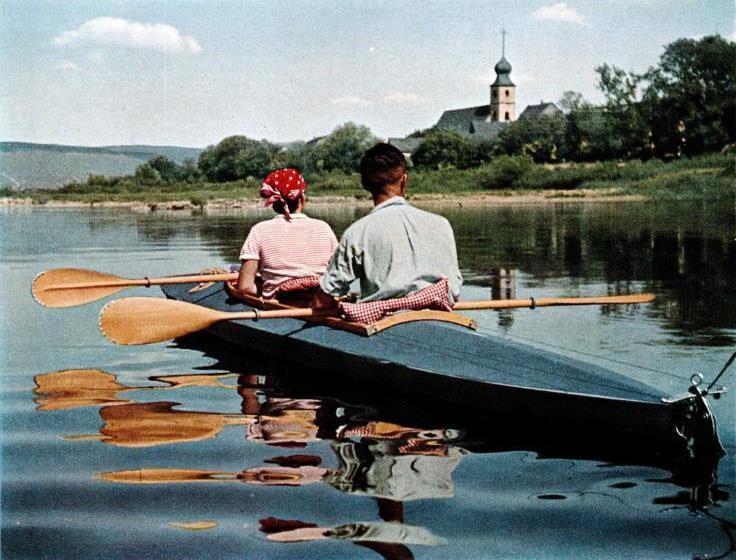
Before color photography could even be possible, it was necessary to have black and white films which were sensitive to the entire gamut of visible light.
Originally, the chemicals used for making photographic plates could only register blue light. In 1873, orthochromatic plates became available, based on the work of Heinrich Vogel, who used dyes to sensitize the photographic emulsion to green light. This principle was later extended by others to allow photographic plates to register even red light; one date I have seen for the availability of panchromatic plates is 1905, although other sources give earlier dates.
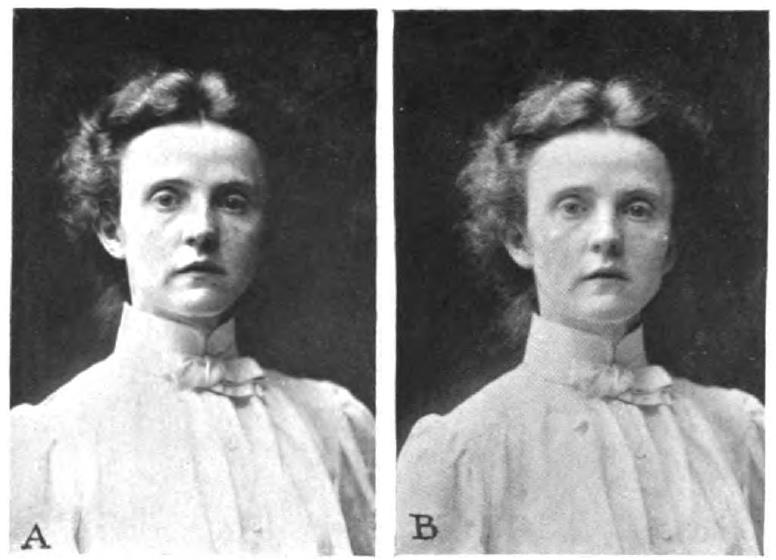
The image above illustrates the difference in appearance of black and white photographs caused by sensitizing the emulsion. The two photographs are portraits of the same woman in the same pose; the first is taken with a plain emulsion that is not sensitized, and the second is taken using an isochromatic emulsion. Isochromatic plates were a later development of orthochromatic plates with broader sensitivity to light with longer wavelengths, but not so broad as that of panchromatic plates; one account credits the isochromatic emulsion with sensitivity to yellow, orange, and some shades of red, although not the deepest ones. Another source claims the terms orthochromatic, isochromatic, and panchromatic were used indiscriminately, and basically meant the same thing.
One important extension of the range of orthochromatic films was through the use of eosin as a sensitizer. Several researchers, including Colonel J. Waterhouse and Heinrich Vogel, noted the merit of eosin, but it was John Clayton (presumably not also Lord Greystoke) and Pierre Alphonse Attout-Taillefer (1853-1896) who, by dissolving eosin in ammonia, were able to make practical use of it as a sensitizer in 1882. This allowed plates to be sensitive to yellow and even orange, but not red. I mention their names as the sources I first encountered gave only their surnames, and the full names were quite difficult to find, so I thought that after digging them up, they were worth sharing.
Incidentally, one Pierre-Alphonse Attout-Taillefer (1854-1895) was a famous architectural painter. I still am not entirely certain if he was the same person who partnered with John Clayton in dissolving eosin in ammonia, or if this is someone which which he is not to be confused; the dates of birth and death given in Wikidata are one year different from those given on a web site for the photographic chemist, but errors of only a single year are possible.
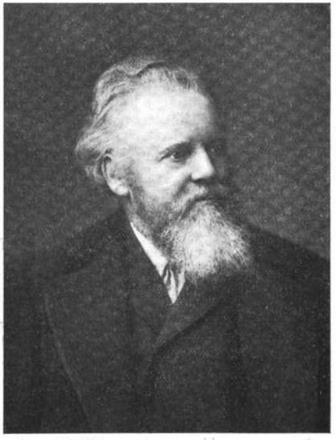
Heinrich Vogel, pictured at left, after inventing the orthochromatic emulsion, continued to play a role in extending the sensitivity of photographic emulsions further. In 1884, he used cyanine as a sensitizer, producing an emulsion that had some degree of red sensitivity, but it required the use of a dark red filter to balance its red sensitivity to that for other colors. Being sensitive to everything but the deepest red, this could be considered an example of an isochromatic film.
The names "orthochromatic" and "isochromatic", of course, imply that the films they describe have achieved the goal of reproducing scenes with full fidelity regardless of color, which goal was not in fact achieved until the advent of panchromatic film. However, in one way, I am somewhat surprised that unlike orthochromatic film, isochromatic film fell into disuse. I would have thought that a film that was almost as good as panchromatic film, but which could still be worked on in a darkroom with a suitable safelight, one that only used the deepest red light to which it was not sensitive, would have been a highly practical kind of film to have.
The panchromatic emulsion was finally achieved by E. König in 1905, working at the German chemical firm Hoechst, who used pinacyanol as a sensitizer; later panchromatic emulsions used additional related chemicals as sensitizers to boost the level of sensitivity to red.
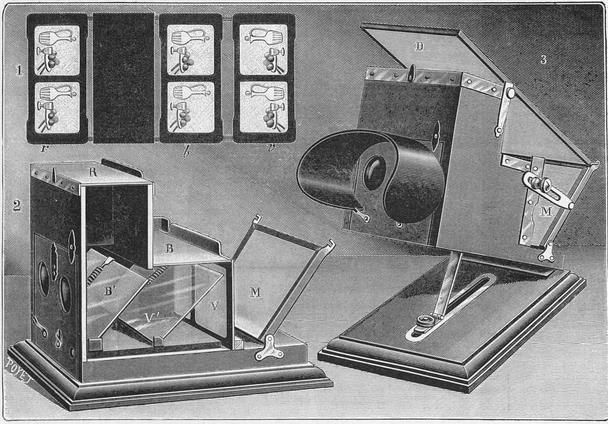
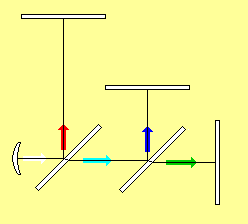
The earliest known method of taking color pictures was by using three glass plates or sheets of black-and-white film, with dichroic mirrors being used so that three pictures corresponding to a color separation of the scene being photographed are taken. This method was later used in many color television cameras. An illustration, from a contemporary engraving, of such a photographic apparatus is shown at left; this example has the additional complication that it takes a stereo pair of color images, as can be seen by careful examination of the image.
At right is a diagram showing which color goes where in the apparatus illustrated on the left of the image at left, as that may not be immediately clear.
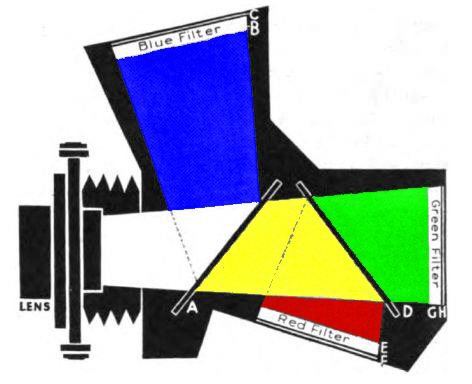
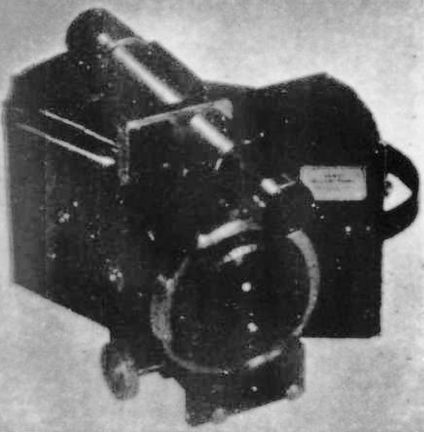
At left is a diagram showing how a modern camera, working on the same principle, worked; the Devin Tri-Color shown at right. This camera, from 1938, also exposed glass plates rather than roll film. Note that while the order of colors is different than in the early color camera depicted, the two mirrors used also reflected a red image and a blue image to the side, leaving the green image to be formed from the light that passed through both mirrors.
I presume this was no coincidence, and that it was easier to make dichroic mirrors that reflected either all wavelengths shorter, or all wavelengths longer, than a certain value than one with two points around which a change from reflecting to passing through took place.
However, the diagram shows blue, red, and green filters in front of the photographic plates. Does that mean that half-silvered mirrors, instead of dichroic mirrors, which are more expensive, were used in this camera, in which case Green being last would be a coincidence, or were the filters merely intended to supplement the color separation provided by dichroic mirrors?
As a brochure for this camera is noted, on a web site, as stating the camera used "very thin pellicle mirrors", it may well be that it used filters and not dichroic mirrors as its means of separating the three additive primary colors, even though this would have meant the camera would have been less efficient at utilizing light.
Incidentally, I was originally going to flip the photo at right, reversing left and right, compared to its original appearance in a 1940 advertisement. That was because otherwise the photo could only be related to the diagram at left if one assumed it was to be understood as being in the unconventional perspective of looking at the camera from the bottom, rather than the top. However, looking again at the diagram, the axle connecting the two knobs used for focusing are shown in front of the bellows, and as one can see from the photo of the camera, they are below the lens, so evidently that was precisely the perspective that was intended.
Also, I retouched the diagram at left to put the color back in, as my source was black-and-white.
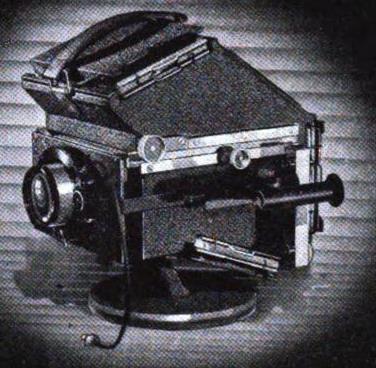
And here is an image of another modern color camera working on this principle, the Lerochrome Daylight Special, from a 1939 advertisement.
But another very early method of color photography, although too difficult and impractical for regular use, produced perhaps the best color photographs ever made, surpassing even Kodachrome in quality!
I refer to the method of color photography for which Gabriel Lippmann won the 1908 Nobel Prize (in Physics); this method is based on recording interference patterns in very high resolution film, and, thus, is somewhat related to the much later invention of holography. It was necessary to use mercury to have a reflecting surface temporarily at the back of the film when the photograph was being taken, but not afterwards.

While it may not really qualify as a method of color photography, what is perhaps the earliest method of making color photographs, which was quite commonly used, was to take black-and-white photographs, and use special transparent paints to apply colors to them.
An example of a photograph retouched in this manner is shown at right; this photograph is from the World's Columbian Exposition in Chicago in 1893, of the Statue of the Republic.
Before plunging into the new world of digital photography, there is another photographic innovation which I have entirely neglected to mention until now.
Canada balsam is a substance made from the Canadian balsam fir tree; it's used in connection with microscope slides, and it was formerly also used to join lenses together into compound elements.
On the initial page of this site, I mentioned that Calcite, unlike Fluorite, is too strongly birefringent to be used in lenses. Something called a Nicol prism can be made by joining together suitably shaped pieces of Calcite, cut along the right crystal axis, with Canada balsam - because its index of refraction lies between that for the ordinary and extraordinary rays within Calcite, and so total internal reflection can take place for just one of them. So a Nicol prism is one way to obtain polarized light.
For most purposes these days, though, there is now a cheaper and more convenient way to filter light by polarization; use a sheet of plastic that contains a layer of iodine crystals that are all in the same alignment.
That material is called "Polaroid", and its invention by Edwin Land led to the founding of The Polaroid Corporation.
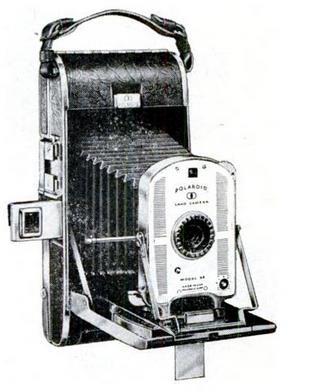
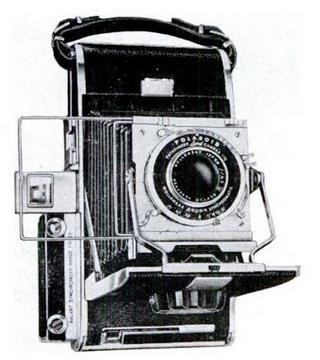
As is well known, however, after that invention, Mr. Land did not rest on his laurels. Starting in 1948, the company offered to the public cameras that took pictures... that developed themselves in seconds.
On the left is shown the Polaroid Model 95, one of their earliest instant cameras, and on the right is shown the Polaroid Pathfinder, with a bellows that allows for tilt and rotate movements.

While the advertisement at left is from 1957, after the introduction of the Polaroid instant camera in 1948, the advertisement does state that the company had been making this sort of camera for over 25 years.
Thus, it indeed does demonstrate that the Polaroid instant camera was answering a need that had already been felt.
The Jano camera was a black-and-white camera which included a space behind the film plane into which the photographer could stick his hand, and with a viewfinder-like means of allowing him to watch himself work, to develop the photograph just taken with this camera.
It was intended for the use of street photographers who could use it to take photographs of people, and then quickly develop them to sell the photographs to them.
When I first encountered (only recently, when working on this web site) this advertisement, my mind hearkened back to the events of the sixth chapter of Ian Fleming's first James Bond novel, Casino Royale; was it a pair of cameras of this kind that were painted bright red and bright blue for the assassination attempt gone wrong?
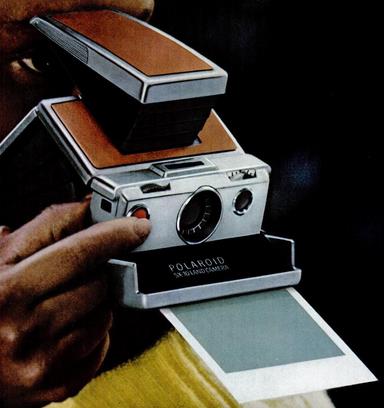
In 1973, Polaroid came out with a compact camera that made taking instant pictures even more convenient, the Polaroid SX-70. It folded flat for carrying, and it was even a reflex camera. A picture of one held in a person's hans to take a picture is shown at right. Later on, they made other cameras using the same film offering different features; several were less expensive than the initial model.
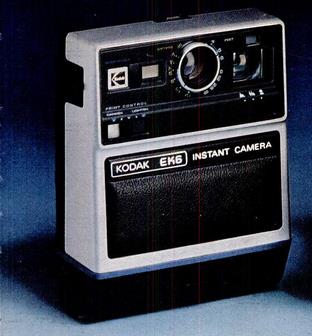
Since Polaroid's basic patents on instant photography, dating from 1948, had expired, the firm of Eastman Kodak was emboldened, in 1976, to offer a camera, the EK6, shown at left, which offered functionality similar to that of the SX-70. Polaroid took legal action against them, and won.
Not only was it found that Kodak had infringed some of Polaroid's more recent patents, but because Kodak was so dominant in the regular film industry, the judge permanently prohibited Kodak from making any instant photography products in future.
So as not to abandon those who purchased these cameras for which they could no longer make film, they offered their owners postage paid mailers to send them in and recieve either a free Kodak disc camera or $50 in coupons for Kodak film, as they chose.
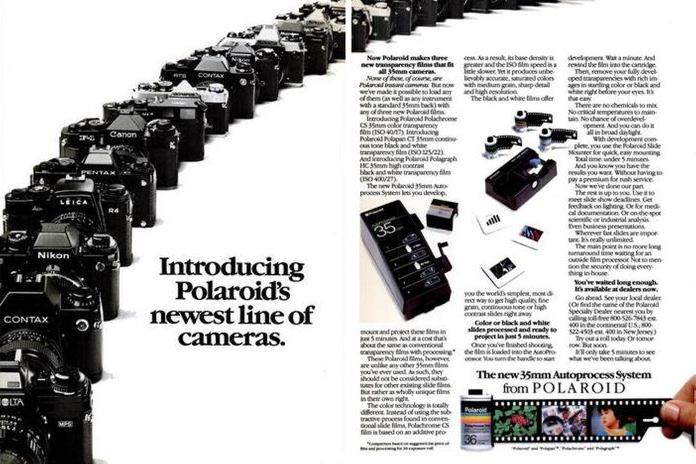
In 1983, Polaroid brought out a very innovative product that would have been the answer to some photographers' prayers; particularly those using Stereo Realist cameras, or Widelux cameras, or any other kind of camera using 35mm film that had a frame size other than the 8-perforation standard established by Leica.
A compact unit could develop, in five minutes, a roll of special 35mm slide film from Polaroid.
Three kinds of film were available: a color film, Polachrome CS, a black and white film, Polapan CT, and a process film (that is, a film used to copy material that is black and white only, without shades of gray) Polagraph HC.
The speeds of those films, however, were uninspiring in at least some cases: the color film was 40 ASA, the black and white film 125 ASA, but the process film was 400 ASA.
The color film was only 40 ASA, slower than Kodachrome-X, because it had to use an additive process, like Autochrome or Dufaycolor, rather than a subtractive one. In the case of Polacolor film, the film was covered in horizontal stripes of red, green, and blue; green was the narrowest, and blue the widest, to compensate for the relative luminosity of each color.
However, in Polacolor still picture film, the difference in width between the different color stripes was modest (Blue: 9.49 microns, Red: 8.38 microns, Green: 8.16 microns) whereas in Polavision color movie film, which preceded it, the difference was more pronounced (Blue: 6.16 microns, Red: 5.40 microns, Green: 5.37 microns) and in the movie film the stripes were vertical instead of horizontal.
Waiting until a roll of film has been finished, and then bringing it home to develop, isn't quite as "instant" as having it pop out of the camera in 60 seconds. That may have decreased its appeal a bit, but it's generally believed that the slow speed of the color film in particular is what led to the product selling poorly.
The basic principle of Polachrome film was previously used in 1977 for a form of instant movie film called Polavision; this was the product that was withdrawn from the market after only two years. Polachrome CS film, on the other hand, may have been discontinued only in 2003, which would have meant that it was available for 20 years; however, the AutoProcessor required to develop the film may have been discontinued at an earlier date, with the film continuing to be produced to support its users.
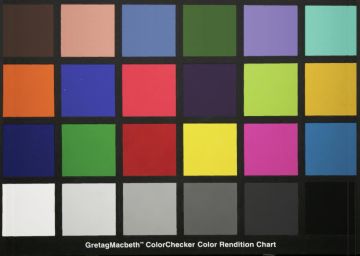
The image at right is taken from the digitization of a very old book placed online for free download.
Obviously, its purpose is to allow people to compare this photograph of a standard color chart with the actual color chart itself to determine how accurately the book was imaged.
The particular color chart used, however, is one that is very popular with serious professional photographers. It's available at many fine photography stores... and its price may seem a bit expensive for such a chart. But there is literally more to it than meets the eye.
The 1976 paper A Color-Rendition Chart by C. S. McCamy, H. Marcus, and J. G. Davidson explains the secrets of this chart. Some of the color squares on the chart are made using especially chosen and mixed paints to have spectral reflectance characteristics which closely match those of real-world items commonly photographed, the colors of which it is desirable to get right.
Specifically, in the top row of the chart, the first and second squares are designed to imitate two shades of human skin; the third the blue of the sky, the fourth is designed to imitate leaves, and the fifth matches the spectral reflectance curve of the blue flower of the chicory plant.
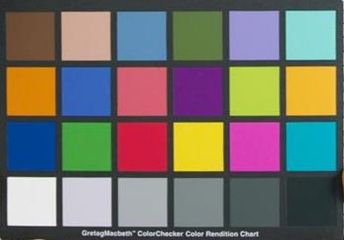
On the left, from an image graciously placed in the public domain by Richard F. Lyon on Wikipedia, is an image taken by a protype camera using a Foveon sensor for the purpose of calibrating a portrait photography session, which is a common use of this chart.
The first company to sell these charts was simply named Macbeth; it was, however, a subsidiary of Kollmorgen. That company wound up being purchased by Gretag, perhaps less well known as a maker of cipher machines; and currently, after the Gretag-Macbeth division of Gretag was acquired by X-Rite, the making of these charts was placed within a separate company, Calibrite. So the ColorChecker Passport that they make, for example, is a genuine successor to the original with the authentic special color paints making its squares.
Norman Macbeth (1873-1936: there are several other famous people with this name; a critic of the Neo-Darwinian synthesis, a golfer, and a painter) founded the Macbeth Daylighting Company Incorporated in 1915; one of its first products was an "illuminometer", which was an early device for measuring the brightness of light. They also made lamps which approximated sunlight, and color filters. The merger with Kollmorgen took place in 1965, and then the company acquired the Munsell Color Company in 1970.